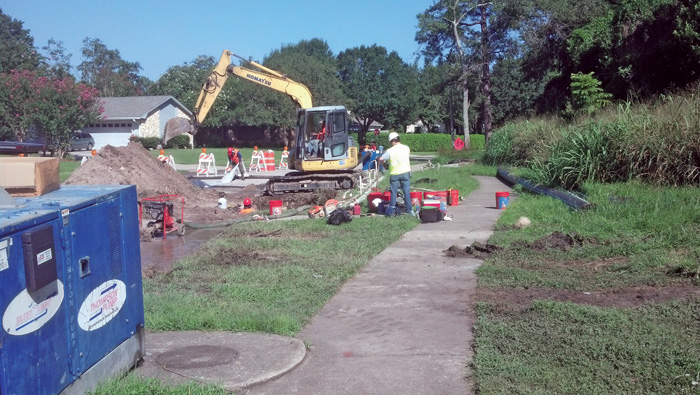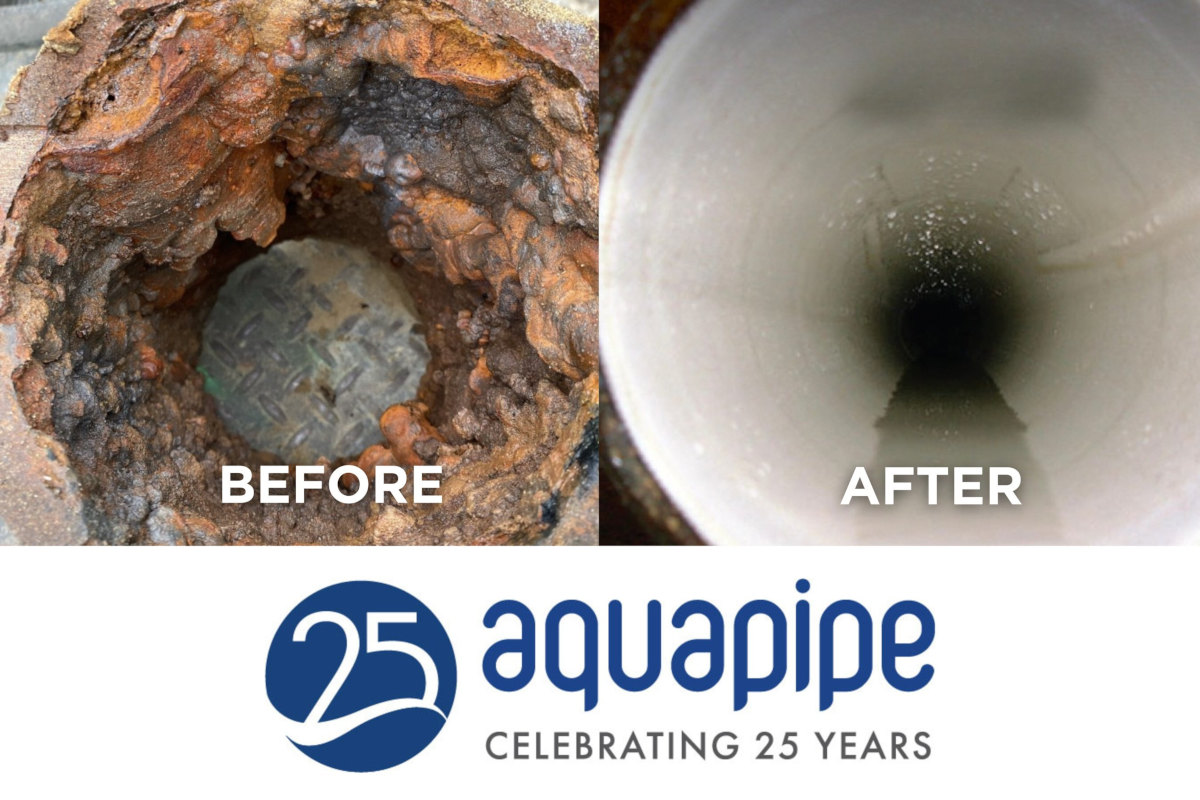Education and Data Are Key to Overcoming Regulatory Hurdles to AC Pipe Replacement Projects
March 18, 2014
 During the post-World War II era, roughly 600,000 miles of asbestos cement (AC) pipe was laid throughout the United States and Canada. These pipes — many of them up to 70 years old — have approached the end of their lifecycle and are corroding, cracking and breaking.
During the post-World War II era, roughly 600,000 miles of asbestos cement (AC) pipe was laid throughout the United States and Canada. These pipes — many of them up to 70 years old — have approached the end of their lifecycle and are corroding, cracking and breaking.Yet efforts to replace or upgrade them have languished largely because of a confusing patchwork of state and federal regulations and a misunderstanding of the risks associated with AC pipe replacement. And despite the best efforts of municipal engineers and the contractors they work with, obtaining the necessary approvals for these projects continues to be slow.
However, there are reasons to believe this process will become easier in the near future, paving the way for more aging AC pipe to be upgraded.
But to understand where we’re headed, it helps to look at the recent history of asbestos and how it influences our present situation. AC pipes were installed in the 1940s, 1950s and 1960s when asbestos cement was valued for its strength, durability and ease of use. But as we know, asbestos was also frequently used in building materials, often as insulation and ceiling tiles and that’s where problems surfaced.
In the 1970s, it was determined that asbestos was hazardous to humans who inhaled its fibers over long periods. The news media widely reported on the topic, showing footage of people in hazmat suits removing asbestos-containing materials from hospitals, offices, schools and other buildings. The U.S. Environmental Protection Agency (EPA) began regulating asbestos and limited its use. All of this contributed to a general unease among the public about the mineral, which has translated into a sense of unease by regulators about AC pipe replacement.
Needless to say, this has complicated the issue of AC pipe renewal, even though science and common sense make it clear that AC replacement is safe when proper methods are employed and precautions taken. Still, regulatory bodies at the federal, state and local levels don’t agree on how AC pipes can safely be replaced. EPA has deemed it safe to replace them, and has even said that the popular pipe-bursting method is permissible, but stops short of providing specific guidance on treating broken pieces of old AC pipe, which are considered a regulated asbestos-containing material (RACM) that is subject to National Emissions Standards for Hazardous Air Pollutants (NESHAP).
This places water utilities and contractors in a difficult position. If they take action, they risk spending valuable time — even years — attempting to get the necessary permits and approvals with no guarantee of a constructive outcome. But if they don’t take action, the pipes under their watch continue to decline and put the infrastructure at risk.
The City of Casselberry, Fla., found itself in such a position in 2009 when it embarked on what would become a two-year effort to get full approval for an AC pipe renewal project. The City had 35 miles of AC water main that needed to be replaced. Water resources manager Edward Alan Ambler struggled to get permission from a variety of local, state and federal agencies. Most challenging was getting approval from the Florida Department of Environmental Protection’s Division of Air Resource Management. Ambler encountered a lot of misconceptions about risks of AC pipe, and educating officials about the rehabilitation process and why it was safe became a near full-time job of presenting information and providing background briefings and materials for officials unfamiliar with the process but whose approval was critical. “We even got resistance within many neighboring agencies based on misgivings and ignorance about asbestos,” said Ambler.
 The fact that the AC pipe renewal method most commonly employed is called pipe bursting doesn’t help. It sounds like something that will spew asbestos fibers far and wide — but it’s nothing of the sort. Pipe bursting is a controlled process that takes place 3 to 5 ft or more underground. It involves inserting a cone-shaped expander into the existing pipe to break it while simultaneously pulling through the new pipe in its place. As the new pipe enters, the old pipe crumbles gently and remains impacted in wet soil where it is contained and harmless. In addition to being a safe method of replacement, it’s also one of the most cost-effective methods. And residents like it because it can be done quickly with minimal disruption to the community and the environment.
The fact that the AC pipe renewal method most commonly employed is called pipe bursting doesn’t help. It sounds like something that will spew asbestos fibers far and wide — but it’s nothing of the sort. Pipe bursting is a controlled process that takes place 3 to 5 ft or more underground. It involves inserting a cone-shaped expander into the existing pipe to break it while simultaneously pulling through the new pipe in its place. As the new pipe enters, the old pipe crumbles gently and remains impacted in wet soil where it is contained and harmless. In addition to being a safe method of replacement, it’s also one of the most cost-effective methods. And residents like it because it can be done quickly with minimal disruption to the community and the environment.Ambler took pains to explain in great detail why pipe bursting was safe, emphasizing that it all occurs underground where broken pipe is contained in wet soil. He explained the standards he followed, such as the AC pipe handling procedures issued by the American Water Works Association (AWWA). When asked what advice he would give to others in a similar situation, he replied, “Don’t take no for an answer.”
You may wonder how an example of one municipality’s two-year struggle to get approval for AC pipe bursting will help other utilities win support for their projects. The Casselberry project has allowed Battelle to conduct important research to provide additional assurance that pipe bursting is safe. During Casselberry’s project, Battelle has been conducting in-depth research and data collection to determine the environmental impact of various AC pipe renewal methods, including pipe bursting. The research is commissioned by the U.S. EPA and the Water Research Foundation. We’ve tested the air as pipe bursting is being conducted and we’ve tested the soil and water before and after repairs have taken place. We’ve conducted tests to determine the extent to which broken AC pipe moves within the soil. In every case thus far, our preliminary data show that AC pipe bursting is safe for workers, communities and the environment.
Battelle is also looking at the cured-in-place pipe (CIPP) lining method of renewal, which has been shown to be a safe and technically viable alternative to replacing AC pipes. Instead of breaking the existing pipe, CIPP allows you to insert a new pipe within the old pipe.
As our research is completed this summer, we will share our findings with the broader water infrastructure community so that they can be used to educate and provide assurance to agency officials and others whose approval is needed in AC pipe renewal projects. We know that this will not win over every official or lead to a set of uniform and clear regulations. There still will be challenges in overcoming the inertia that is an ongoing fact of doing business where many stakeholders and interests are represented. But it will provide some important information in making a more persuasive case for AC pipe rehabilitation. I also hope the data can be used to support an EPA-approved alternative to NESHAP, which would make it easier for state and local regulators to make decisions on these projects.
The example of Casselberry also provides an important case study — a path forward — in how to navigate the process, showing that persistent education can pay off. There’s certainly more work ahead on this issue, but the progress we’re seeing should give us cause for optimism.
John C. Matthews is principal research scientist and water infrastructure lead at Battelle Memorial Institute. He holds a Ph.D. in civil engineering from Louisiana Tech University.




